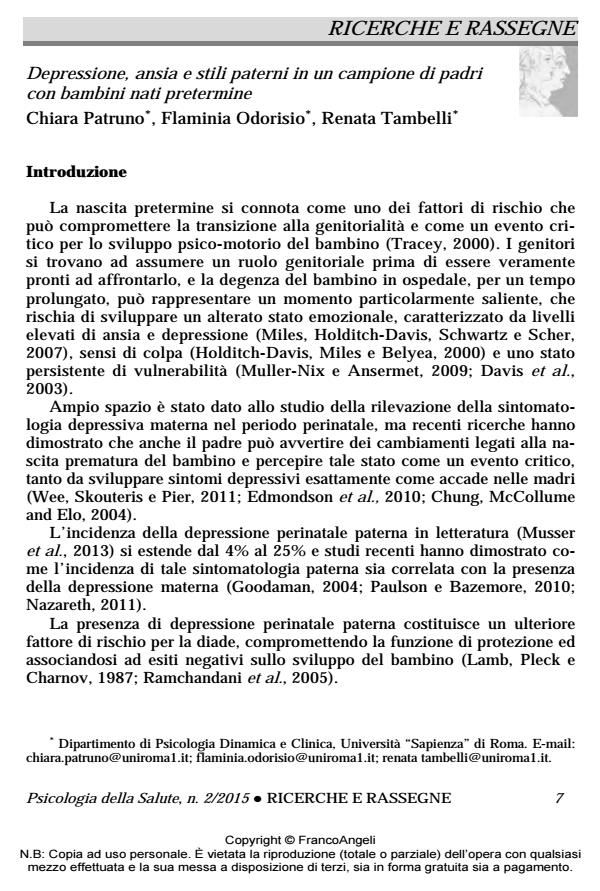Depression, anxiety and paternal styles in a sample of fathers with premature babies
Journal title PSICOLOGIA DELLA SALUTE
Author/s Chiara Patruno, Flaminia Odorisio, Renata Tambelli
Publishing Year 2015 Issue 2015/2
Language Italian Pages 19 P. 7-25 File size 124 KB
DOI 10.3280/PDS2015-002002
DOI is like a bar code for intellectual property: to have more infomation
click here
Below, you can see the article first page
If you want to buy this article in PDF format, you can do it, following the instructions to buy download credits

FrancoAngeli is member of Publishers International Linking Association, Inc (PILA), a not-for-profit association which run the CrossRef service enabling links to and from online scholarly content.
The purpose of the present study aims at assessing the experiences of depression and anxiety in fathers of premature babies and at showing how such experiences can affect the paternal representations and the emotional availability in free-play interactions. A group of 68 fathers has been selected and endowed with the following instruments: the STAI-Y1 self-report in order to detect the status anxiety; the EPDS in order to evaluate the depressive symptomatology; the IRPAN interview in order to assess the parental representation at 4th month of corrected age and the videotape of interactive sequences that have been coded by rating scales of the EAS interaction at 6th month. The results highlighted that the fathers of premature babies show a 32% risk of anxiety, a 19% risk of depression, a prevalence of 50% integrated/balanced representations, 45% restricted/ disinvested representations and 4% non-integrated/ambivalent representations. In the present study the anxious fathers have a less effective interaction than those who do not show an anxious symptomatology, proving to be less sensitive since they do not effectively structure the recreational interaction and sometimes becoming intrusive. The children of these fathers are less involved in the interaction with the adult. The results showed that depressed fathers are less sensitive in the interaction with their children. The data about the influence of parental representation on the interaction explained how fathers with an integrated/ balanced representation, while showing high levels of anxiety, are characterized as able to effectively structure the recreational interaction - unlike the other representation’s categories - therefore demonstrating how the anxiety factor is functional to their abilities.
Keywords: Premature birth, parenting, paternal depression, paternal anxiety, paternal representations, father-child interactions
Chiara Patruno, Flaminia Odorisio, Renata Tambelli, Depressione, ansia e stili paterni in un campione di padri con bambini nati pretermine in "PSICOLOGIA DELLA SALUTE" 2/2015, pp 7-25, DOI: 10.3280/PDS2015-002002